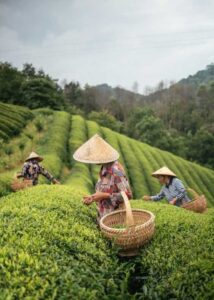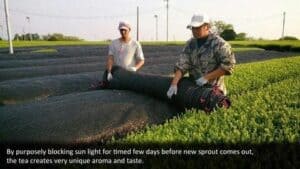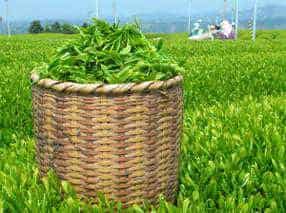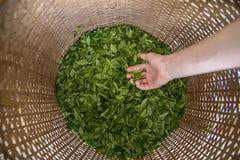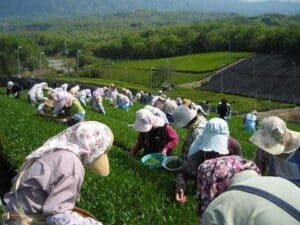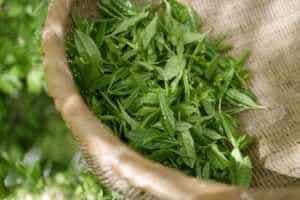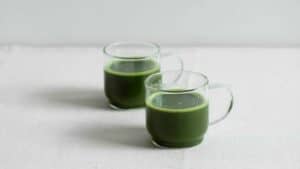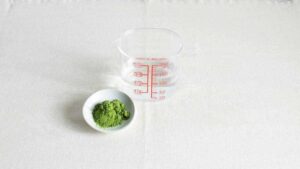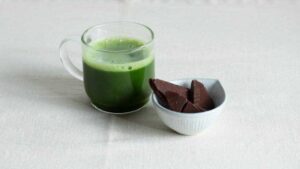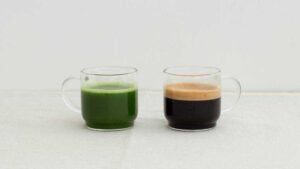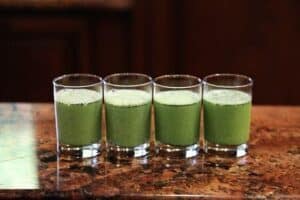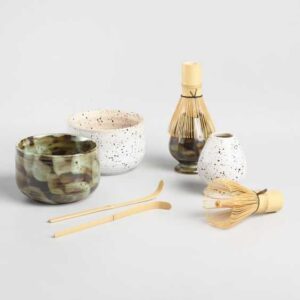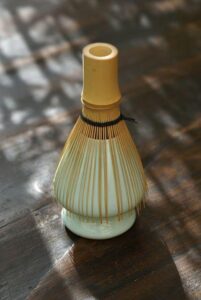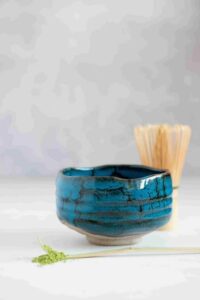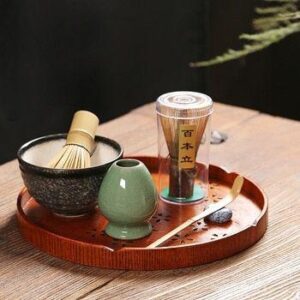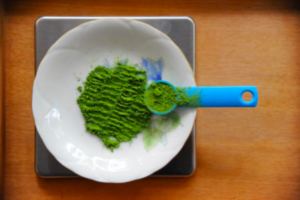Tag: ชาเขียวมัทฉะ
The 5 Most Common Mistakes in Brewing Matcha
10 things about growing green tea that you (probably) never knew
Green tea is at the heart of Japanese culture. From the harvesting to the preparation of the leaves, every step is meticulous, complex and deeply rooted. Green tea harvested in Japan has certain flavors and nutritional properties that are different from teas from China and other parts of the world. Here are 10 things about Japanese green tea that you (maybe) didn’t know.
- The first harvest of the year, the tea leaves are the most nutritious and sought after. The first harvest begins in May and lasts for several weeks until June. This harvest is known to produce the highest quality green tea leaves, largely due to the slow growth during the cold months, which makes the leaves denser in nutrients, resulting in a better flavor. The leaves picked in spring contain three times as much L-theanine as those produced in later harvests, giving this first batch of tea a sweet and mild flavor.
- The second harvest of the year in June and July is very hot because it is summer, making harvesting very difficult. During this time, the tea leaves grow faster and are of lower quality, with a more bitter taste, requiring more efficient management of both employees and harvest control.
- KANREISHA CURTAIN or black curtains that are popularly used to cover the ground can be used to protect tea plants from direct sunlight. About a month before each harvest, tea plants are covered with curtains to limit the amount of sunlight that does not directly hit the tea plants. There are two types of curtains used in Japan: the type that uses direct cloth to cover the plants and the type that uses awnings to block the sunlight. Each tea plantation has different uses. Some places use both types. Tea plants that are covered with such curtains before harvesting will help the tea to develop a sweet taste.
- Each tea leaf is carefully selected by the tea pickers. Compared with the tea leaves selected by machine, the quality of the tea leaves is not as high as those picked by hand. The taste of the tea leaves by hand is more mellow and the aroma is more delicate. The best time to pick the leaves is when there are three to five young plants and the leaves are of the right size. Picking too early means less yield. Picking too late affects the quality of the tea. Even one day can make a difference and make the leaves bitter. Therefore, it is very important to pick the tea leaves at the right time and pick them quickly and all at once. Therefore, each worker must use his experience to pluck the leaves quickly and meticulously.
- Japan actually produces less tea than other countries. Despite its strong green tea culture, Japan produces only 7% of the world’s green tea. Most of it is consumed domestically, and only a small portion is exported to other countries. The Japanese consume 95% of all tea production in the country, leaving only 5% exported to other countries.
- The most popular method of storing tea leaves is still the use of traditional wooden baskets. Despite the widespread use of machinery and technology, traditional wooden baskets are still used to store tea.
- In the fall, tea plantation workers start preparing the farm for the next year’s harvest. Green tea trees are pruned in the autumn months of October and November. Pruning at this stage ensures that the young leaves of the old leaves do not mix with each other and reduce the harvest in the spring of the following year. Failure to prune at the right time will harm the tea trees and may even result in weak tea trees. Therefore, in late summer and early autumn, the soil must be enriched and the pH of the soil adjusted to the appropriate level.
- There is a tea harvest tour. Obubu is the Kyoto word for a type of green tea, which is one of the most expensive teas in Japan, costing around 14,000 yen per kilogram. For over 800 years, the farm in rural Kyoto Prefecture has been open to visitors and the public during the harvest season. It begins with a morning tour of the farm and the opportunity to pick your own tea leaves. The staff will demonstrate how to pick the leaves, and visitors will be given a traditional wooden basket to collect the leaves. The leaves can then be sent for processing or roasted, ready to be served as a tea drink made from the leaves you have picked for a delicious cup of tea.
- Green tea plants require special care during the winter. Dry leaf straw and bamboo husks are placed beside the plants to provide warmth during the cold and snowy months, act as fertilizer and help maintain the soil at the right level of moisture. Since many plants are prone to disease and die during the winter, the tea plants must be well cared for to ensure they are ready for the next harvest.
- Harvesting in Japan is different from the techniques used in China, as the Japanese pick certain leaves at different times of the year, while in China they usually pick all the leaves at one time.
The process of harvesting tea leaves is a complex task that takes a whole year. From the first harvest to the last, farmers in Japan work tirelessly to produce the highest quality tea possible for the best tasting tea.
Source
Article from: Fuwafuwa
Iced Matcha Latte Iced Matcha Latte
Turn your cold green tea into a premium matcha latte, a popular menu item of the shop that is so delicious you have to tell others!!
Good quality matcha powder will give a beautiful green color. When poured over fresh milk, you will see a layer of emerald green gradually seeping down. The method of making it is not difficult. Especially if you have the equipment to help, it will not take long to brew. Let’s see the ingredients and brewing method. ^^
Dissolving aid
- Matcha powder sieve
- Chasen (茶筅) is a bamboo stick used to grind green tea powder to prevent it from clumping.
- Portable milk frother (Mini milk mixture)
- Shaker cylinder
Ingredients for a 16 Oz. glass.
- MATCHAZUKI Excellent Grade Matcha Powder 3 grams (~1.5 teaspoons)
- Warm water 40 ml
- Fresh milk 150 ml
- 10 ml syrup (~2 teaspoons)
- ice
Brewing process
1. Dissolve matcha powder in warm water by sifting matcha powder through a sieve into a cup or bowl, then pour in warm water and use a Chasen or milk frother to beat the tea powder into the water. Then set aside.
2. Add ice to another glass.
3. Add syrup according to desired sweetness.
4. Pour in fresh milk and mix with syrup.
5. Pour the dissolved matcha over the fresh milk.
Or you can watch a video on how to make it here ^^
*** If you don’t have a dissolving device, try this method.
———————————-
Mastering the Art of Adding a Matcha Shot to Your Beverage
เวลาสั่งกาแฟ จะเห็นว่าในเมนูบางร้าน นอกจากเมนูกาแฟปกติ ก็จะมี option เพิ่ม Espresso shot อยู่ในนั้นด้วยเพื่อเอาใจคนชอบดื่มแบบเข้มๆ แต่ถ้าเป็นเมนูชา ไม่ว่าจะเป็นชาเขียว ชาโฮจิฉะ หรือชาไทย เราแทบจะไม่เห็นการเพิ่มช็อตชา เพื่อให้ชามีความเข้มข้นมากขึ้น ซึ่งจริงๆแล้ว ในต่างประเทศมี Option เพิ่มช็อตชา หรือแม้กระทั่งการขาย Matcha shot เหมือนการขาย Espresso shot ก็มีเช่นกัน ซึ่งมีประโยชน์ต่อสุขภาพพสมควรเลยทีเดียว แต่คนไทยจะไม่ค่อยคุ้นชินกับการดื่มชาเป็นช็อตแบบนี้
หากใครเป็นคนที่รักการดื่มชาเขียว จะพอทราบว่าการชงชาเขียวตามแบบฉบับคนญี่ปุ่น จะมีการชงแบบ Usucha และ Koicha ( ดูรายละเอียดเพิ่มเติมได้ที่ https://bit.ly/2RrD29N ) ซึ่งการทำ Matcha Shot ก็เป็นการดื่มที่เกิดขึ้นจากการที่ผู้คนพยายามหาวิธีการใหม่ๆ เพื่อให้ได้ลิ้มรสของชาเขียวเข้มข้น
ซึ่งความน่าสนใจของ Matcha shot คือ อัตราส่วนของน้ำต่อมัทฉะที่ใช้ในการชงนั้นใกล้เคียงกับ Usucha เพราะ Matcha shot ประกอบไปด้วยผงมัทฉะ กับน้ำร้อนเท่านั้น
ผงมัทฉะชนิดใดที่คุณควรใช้ในการทำ Matcha Shot ?
แนะนำเป็นเกรดพิธีการ ( Ceremonial Grade ) เพราะ Matcha shot มีจุดเด่น คือ รสชาติและสีของชา ซึ่งจะมาจากคุณภาพของผงมัทฉะล้วนๆ เพื่อให้ได้ Matcha shot ที่สีเขียวสดใส และ รสขมที่ชัดจากผงมัทฉะเพียวๆ การเสิร์ฟ Matcha shot ตามมาตรฐานคือ
ผงมัทฉะ 1 ช้อนชาหรือ 2 กรัม กับน้ำ 70 – 100 ม.ล. โดยน้ำมีอุณภูมิอยู่ที่ 80 องศาเซลเซียส หากเป็นน้ำที่เพิ่งต้มเดือดๆเลย แนะนำเป็นให้วางทิ้งไว้สัก 5 นาทีเพื่อให้อุณหภูมิน้ำลดลง
หลังจากเทน้ำผสมกับผงมัทฉะแล้วให้ปิดฝาขวดแล้วเขย่าประมาณ 30 วินาที หรือจนกว่าผงมัทฉะจะละลาย เสิร์ฟเป็น Matcha shot ได้เลย แต่ถ้าใครที่ถนัดกับการใช้ฉะเซ็นตี ก็สามารถทำได้เช่นกัน
อย่างไรก็ตาม Matcha shot อาจจะไม่เหมาะสำหรับทุกคน โดยเฉพาะผู้ที่เพิ่งเริ่มหัดดื่มชาเขียว เพราะ Matcha shot จะมีความเข้มข้นกว่ามากในช่วงแรกที่ดื่ม ( คล้ายกับดาร์กช็อกโกแลต 70% ) หลังจากนั้นไม่กี่วินาทีความเข้มข้นนั้น จะเปลี่ยนเป็นรสอูมามิที่ค้างอยู่ในคอ และมีรสชาติชาขมๆค้างอยู่ในปาก หากเพิ่งเริ่มดื่มมัทฉะแนะนำให้ดื่มเป็นมัทฉะลาเต้ หรือเป็นมัทฉะเพียวแบบเย็นจะดื่มง่ายกว่า
หากถามว่าการดื่ม Matcha shot กับ Espresso shot แบบไหนได้คาเฟอีนที่มากกว่ากัน สังเกตได้จากปริมาณคาเฟอีนในมัทฉะขึ้นอยู่กับปริมาณผงมัทฉะที่คุณใช้ ผงมัทฉะ 1 ช้อนชาจะมีคาเฟอีนประมาณ 70 มก. ดังนั้น Matcha shot จะมีคาเฟอีนประมาณ 70 มก. หากเปรียบเทียบกับ Espresso shot ในปริมาณที่เท่ากัน Espresso shot จะมีคาเฟอีนอยู่ที่ประมาณ 80 มก.
ความแตกต่างที่สำคัญระหว่าง Espresso shot และ Matcha shot คือ คาเฟอีนใน Matcha shot จะถูกปล่อยออกมาอย่างช้าๆเนื่องจากมีแอล – ธีอะนีน นั่นหมายความว่า แม้ว่าเครื่องดื่ม 2 ชนิดจะมีคาเฟอีน แต่ Espresso จะมีคาเฟอีนอยู่ในร่างกายเพียง 1 ชั่วโมงเท่านั้น ดังนั้นหากใครที่อยากให้คาเฟอีนอยู่ในร่างกายได้นานขึ้น เพื่อให้มีสมาธิ และช่วยให้สงบนิ่งมากขึ้น แนะนำเป็นให้ดื่ม Matcha shot แทนจะดีกว่า
Matcha shot เป็นเครื่องดื่มชาเขียวที่มีคุณค่าทางโภชนาการค่อนข้างสูง จึงแนะนำให้ดื่มทันทีที่ชงเสร็จ เพื่อความสดใหม่ และเพื่อเพิ่มพลังงานได้ในทันทีหลังจากดื่ม จึงเหมาะกับการดื่มในเช้าวันใหม่ หรือเมื่อรู้สึกเหนื่อยล้าจากการทำงานหนักมาตลอดทั้งวัน หรือจากการนอนไม่เพียงพอ การดื่ม Matcha shot จะช่วยให้รู้สึกกระปรี้กระเปร่าขึ้น เพราะการทำ Matcha shot ถูกดัดแปลงวิธีการชงให้ชงง่ายรวดเร็ว และเพื่อให้ดื่มได้ง่ายๆเพื่อรีบูสความสดชื่นในร่างกาย ทำให้บางคนที่อยากได้คุณค่าทางสารอาหารเต็มๆ
มาเริ่มต้นเช้าวันใหม่ ด้วย Matcha shot อุ่นๆสักแก้ว ดีมั้ยคะ 🙂
ที่มา
https://naokimatcha.com/recipes/matcha-shot/
http://hungarianhousewife.com/afternoon-boost-matcha-shot
บทความจาก : Fuwafuwa
How to take care of your teaware
When it comes to making matcha, the equipment that comes to mind is probably Chasen, a bamboo spoon, Cha-chaku, or Chasen stand. The method of using these equipment can be studied from many websites. However, the correct use of equipment also requires proper storage. Let’s see how each type of tea brewing equipment should be stored.
Start with storing the Chasen or tea brush, the most important tool for making tea. After use, swing it in warm water, focusing on swinging only the part that touches the matcha, do not wash the whole thing. After swinging it for two times, set it aside to dry. If anyone has a Chasen rest, it is recommended to insert it and wait for it to dry. It will be better because this Chasen rest has the advantage of not letting water flow into the handle and it also helps maintain the shape of the Chasen. After the Chasen is dry, store it in a box or in a place with a suitable temperature, not too hot, not too cold, with good air circulation. Most importantly, it must not be too humid or dry. Because if it is too hot or dry, the bamboo will become brittle and break easily. And be careful about humidity or the bamboo will grow mold. As for the ceramic Chasen rest, it helps the Chasen dry quickly and maintains the shape of the bamboo, preventing mold. Just observe carefully if there is a little stain or not. If it is dirty, just wash it and let it dry. Because it is not very dirty. But if it is used for a long time, do not neglect to check if it is still in good condition and suitable for use.
As for the Cha-cha-ku or bamboo spoon, there is a very easy way to store it. After using it to scoop matcha, “do not wash” or “do not let it get wet” at all. Because the Cha-cha-ku is a tool that directly touches matcha. If you wash it, the Cha-cha-ku will have moisture. When you use it to scoop matcha, the moisture will flow to the matcha in the container, causing the matcha to clump together. In addition, washing the Cha-cha-ku too often will cause the bamboo to lose its shape and become old faster. Therefore, it is recommended to use dry tissue paper to gently wipe off the matcha powder. That is enough.
Chawan or tea cup, after use, rinse gently with water. It is not recommended to wash in a dishwasher or dryer. And do not use Scotch-Brite to scrub the cup too hard. Avoid using dishwashing liquid. Should use organic type with mild scent. After washing, it is not recommended to put in high temperature places such as microwave, oven or stove. But the most important point is that Chawan is for brewing matcha tea only. Should not be used to mix with other things. Otherwise, it may smell.
There are some types of equipment that should be washed with hot water before first use and left to dry completely, such as ceramic teapots. After use, it is not recommended to use a dishwasher, dryer or dishwashing soap. For the built-in filter area, squeeze the water out of the spout. Use a toothbrush or toothpick to remove tea leaves stuck in the strainer. After use, always let it dry completely because if stored while still wet, it may cause musty smell or mold.
Source
https://www.worldmarket.com/product/matcha-bowl-and-whisk-tea-gift-sets-set-of-2.do
Article from: Fuwafuwa
Tea Pairing: A Guide to Flavorful Food Combinations
เป็นที่ทราบกันดีว่า ชาเป็นอีกหนึ่งเครื่องดื่มที่จะช่วยเพิ่มและดึงกลิ่นและรสชาติที่ละเอียดอ่อนของอาหารหลายประเภทออกมาได้ เช่นเดียวกับไวน์ ที่พวกเราจะคุ้นเคยกับกฎพื้นฐานที่ว่า ไวน์แดง จะเสิร์ฟกับอาหารที่มีเนื้อแดง ส่วนไวน์ขาวเสิร์ฟพร้อมกับเนื้อปลาและอาหารมังสวิรัติ ดังนั้นการเรียนรู้ว่า ชาชนิดใดสามารถเติมเต็มรสชาติของอาหารได้บ้าง จึงเป็นศาสตร์ที่คนรักชาควรศึกษาเพิ่มเติมไว้เพื่อช่วยให้รสชาติชาเขียวทำให้เมนูอื่นๆในร้านอร่อยมากยิ่งขึ้นนั่นเอง
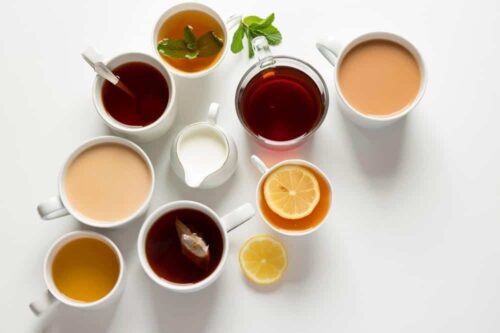
ชาแต่ละชนิดก็จับคู่กับอาหารอะไรเพื่อช่วยดึงรสชาติได้แตกต่างกัน เช่น ชาดำที่มีกลิ่นรสที่ strong และค่อนข้างเข้มข้นไปจนถึงขม ซึ่งมีความคล้ายกับความ Full-bodied ของไวน์แดง จับคู่ได้ดีกับอาหารเนื้อแน่น รสชาติหนักๆ พวกเนื้อย่าง (วัว, แกะ) พาสต้าเนื้อแน่นอย่างลาซานญ่า ชาขาวรสชาติเบาๆ ควรจับคู่กับอาหารที่เบามากเช่น ปลาเนื้อขาวเช่น ปลากะพงหรือชีสอ่อน ๆ ส่วนชาอู่หลงจะแตกต่างกันออกไป จะเข้ากันได้ดีกับของหวาน ผลไม้ ชีส และเนื้อสัตว์รมควัน แต่ถ้าเป็นชา Earl Grey จะเหมาะกับผลไม้และขนมหวาน เค้ก และดาร์กช็อกโกแลต
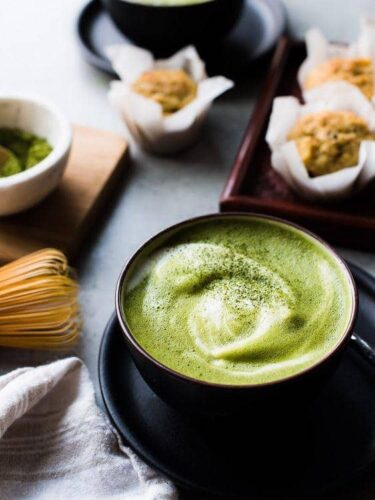
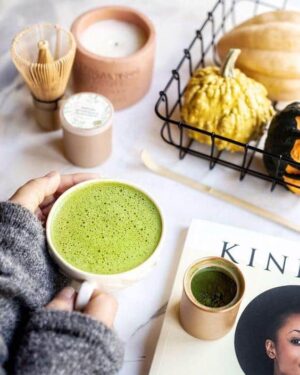
จะเห็นว่า ชา นอกจากจะสามารถเพิ่มรสชาติของอาหารบนจานของคุณได้อย่างแท้จริง ในทางกลับกันการจับคู่ผิดก็อาจจะทำให้อาหารและชามื้อนั้นรสชาติแย่ไปเลยก็มี มาดูกันว่าชาเขียว เหมาะกับการจับคู่กับอาหารชนิดใดบ้าง
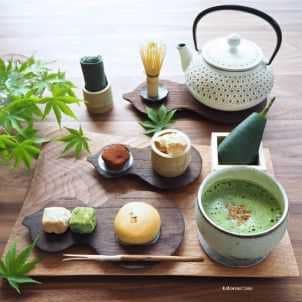
- อาหารญี่ปุ่นและชาเขียว ถือเป็นส่วนผสมที่ดีต่อสุขภาพและเข้ากันที่สุด
อาหารของญี่ปุ่นที่ประกอบด้วยซา ชิมิ ข้าวปั้น ราเมง อาหรกลุ่มนี้จะเข้ากันได้ดีกับชาเขียว โดยเฉพาะเซนฉะที่มีความสมดุลของความเป็นกรดและความหวานที่เข้ากันได้ดีกับรสชาติของอาหารญี่ปุ่นนั่นเอง
- อาหารซีฟู้ด ชาเขียวโดยเฉพาะเซนฉะจะเข้ากันได้ดีกับอาหารทะเล เพราะช่วยเพิ่มรสชาติของกันและกัน ซึ่งส่งผลให้เกิดการผสมผสานที่เป็นเอกลักษณ์ในปากและทิ้งรสขมเล็กน้อยที่ค้างอยู่ในปากซึ่งทำให้ต้องการอาหารซีฟู้ดมากขึ้น
- ขนมที่ใช้ช็อคโกแลต ช็อคโกแลตมีโกโก้ซึ่งให้รสขม หรือจะเป็นดาร์กช็อกโกแลตที่มีโกโก้มากกว่าเมื่อเทียบกับช็อคโกแลตอื่นๆ ทำให้มีรสขมอย่างเข้มข้น หากจับคู่กับชาเขียวที่ผสมผลไม้ จะได้รสชาติที่ลงตัวจากความขมของโกโก้และความหวานจากชาเขียว หากต้องการทานช็อคโกแลตประเภทหวานๆ เช่น ช็อกโกแลตนม ชาเขียวก็เป็นคู่ที่ดี เพราะรสขมเล็กน้อยของชาเขียวจะช่วยเพิ่มรสหวานของช็อกโกแลต
- ไก่ทอดรสชาติที่ได้จากชาเขียวจะเข้ากันได้ดีกับไก่ทอด เพราะชาเขียวจะช่วยลดอาการปากมันเยิ้มที่ได้จากการกินไก่ทอด
- ขนมปังโฮลวีตและชาเขียวเป็นอาหารเพื่อสุขภาพที่ดีเยี่ยมและสามารถทำเป็นอาหารเช้าที่มีคุณค่าทางโภชนาการได้การจับคู่นี้สามารถกระตุ้นการเผาผลาญได้เป็นอย่างดี
จะเห็นว่าชาเขียวเป็นเครื่องดื่มสารพัดประโยชน์ที่สามารถจับคู่กับอาหารได้เกือบทุกชนิด การทานชาแต่ละชนิดกับอาหารแต่ละอย่างจึงมีรสชาติแตกต่างกันไป ทั้งนี้ก็ขึ้นอยู่กับความชอบของแต่ละบุคคลด้วย หากร้านชาไหนที่ไม่มีเมนูของคาวทาานคู่ชาแล้ว ลองดูส่วนผสมอื่นที่มาผสมกับชาเขียวแก้วโปรดของคุณให้ได้รสชาติที่แตกต่างกันออกไป ยิ่งไปกว่านั้นชาเขียวมัทฉะของญี่ปุ่นมักจะมีกลิ่นหอมของแอปเปิ้ลและดอกกุหลาบที่เด่นชัดมากขึ้นเมื่อผสมกับกลิ่นหอมของแตงกวาสีเขียวบางชนิด บางคนผสมกับตะไคร้ ขิง หญ้าฝรั่น แอปเปิ้ล สับปะรด แอปริคอท มะเขือเทศ หรือเหล้ารัม ก็ให้รสชาติที่แตกต่างออกไป เพราะชาเขียวจับคู่กับอะไรก็อร่อย ^^
ที่มา
https://www.teavivre.com/info/how-to-pair-tea-and-food.html
https://www.pinterest.com/pin/100768110397035818/
https://www.japanesegreenteain.com
บทความจาก : Fuwafuwa
The Truth About Drinking Green Tea with Milk: Is It Harmful to Your Health?
อย่างที่รู้กันอยู่แล้วว่าประโยชน์สูงสุดของการดื่มชาเขียว คือ ต้องดื่มแบบเพียวๆ ไม่ใส่นม น้ำตาล แต่ก็ใช่ว่าการใส่นมลงไป จะทำให้สูญเสียคุณค่าทางอาหารของชาไปทั้งหมด เพราะนมก็มีหลายประเภท ทั้งนมสด นมผง นมถั่วเหลือง นมอัลมอนด์ แต่ละชนิดก็ให้ประโยชน์ที่แตกต่างกันออกไป หากคุณต้องการได้รับประโยชน์สูงสุด การดื่มชาเขียวใส่นม จะทำให้คุณประโยชน์ของชาลดลงเท่านั้น แต่จะไม่สามารถขจัดประโยชน์ทั้งหมดได้
ประโยชน์ต่อสุขภาพที่สำคัญอย่างหนึ่งของชาเขียว คือ ประโยชน์จากคาเทชินซึ่งดีต่อหัวใจการไหลเวียนของเลือด คาเทชินเป็นอาวุธสำคัญของธรรมชาติที่เข้าไปทำหน้าที่ป้องกันการเกิดอนุมูล อิสระ และช่วยลดความเสี่ยงของการเกิดมะเร็งในร่างกาย ชะลอความเสื่อมของร่างกายและช่วยลดความเสี่ยงในการเกิดโรคมะเร็งอีกด้วย ซึ่งในนมจะมีโปรตีนที่พบ เรียกว่า เคซีน ตัวนี้จะทำปฏิกิริยาทางเคมีกับคาเทชินและลดประโยชน์ต่อสุขภาพ เพียงแค่ลดประโยชน์ที่ดีลง แต่ไม่ได้ผลิตสารเคมีที่ไม่ดีต่อร่างกาย
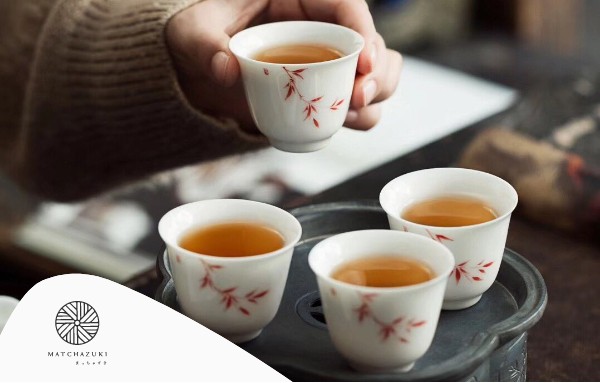
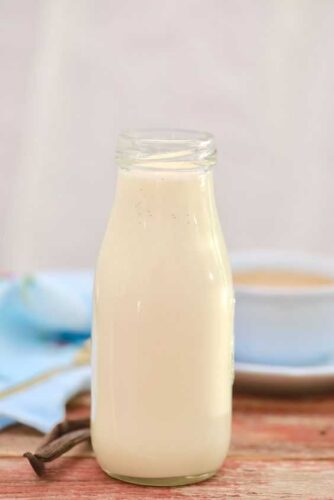
ดังนั้น หากจะช่วยเพิ่มประโยชน์ในการดื่มชาเขียวลาเต้แก้วโปรดของคุณ มีทางเลือกอีกมากมายในการใส่นมลงไป เช่น การเลือกนมถั่วเหลืองแทนนมวัว นมถั่วเหลืองมีเลซิตินซึ่งมีโครงสร้างโมเลกุลที่แตกต่างจากเคซีนดังนั้นคุณจะได้รับประโยชน์อย่างเต็มที่จากคาเทชิน เพียงแค่รสชาติจะแตกต่างกันเล็กน้อยเท่านั้น และยังเป็นทางเลือกสำหรับคนที่แพ้นมวัวอีกด้วย แต่ถ้าาใครไม่ชอบนมถั่วเหลือง ก็ยังมีนมถั่วพิตาชิโอ้ และนมอัลมอนด์ ที่มีคุณค่าทางสารอาหารไม่แพ้กัน
อย่างไรก็ตามสามารถเพลิดเพลินกับการดื่มชาเขียวได้เหมือนเดิม แทนนิน กรดแกลลิก และคาเฟอีน คุณประโยชน์ในชายังคงทำหน้าที่ได้ดีตามปกติเมื่อคุณดื่มชาเขียวใส่นม

ข้อควรระวังสำหรับการดื่มชาเขียวใส่นมโดยเฉพาะอย่างยิ่งร้านที่ขายเครื่องดื่มชาเขียวในราคาถูกมากๆ อาจจะมีการใช้นมผง แทนนมสด จริงๆแล้วนมผง เป็นอีกหนึ่งตัวเลือกใหม่ๆที่เก็บรักษาง่ายเพราะเป็นผงไม่ต้องแช่เย็น แต่บางร้านไม่ได้ใช้นมผงแท้ๆ ราคาจึงถูกกว่านมผงทั่วไปก็มีพบได้ในตลาดทุกวันนี้
หากคุณเป็นหนึ่งในผู้ประกอบการร้านเครื่องดื่มชา กาแฟ นอกจากการเลือกผงมัทฉะที่เป็นองค์ประกอบหลักในการชงเครื่องดื่มแล้ว อย่าลืมที่จะทำความรู้จักกับนม ที่เป็นอีกองค์ประกอบสำคัญด้วย
อย่างนมสดพาสเจอร์ไรซ์ นิยมบรรจุในขวดพาสติก แบบขุ่น กล่องกระดาษ หรือถุงพลาสติก โดยวางจำหน่ายในตู้เย็น หรือ ตู้แช่ ซึ่งมีอุณหภูมิต่ำกว่า 10 องศาเซลเซียส เพื่อไม่ให้นมเสีย เป็นนมที่มีคุณค่า ทางอาหารใกล้เคียงกับนมโคสดมากที่สุด นมประเภทนี้จึงเหมาะกับร้านขายเครื่องดื่มอย่างน้ำชา กาแฟมากที่สุด เพราะหาซื้อง่าย และสะดวก ซึ่งแต่ละยี่ห้อก็จะมีความหอม อร่อยที่ต่างกันออกไป และเป็นนมที่มีคุณค่าทางโภชนาการสูง ข้อจำกัดของนมชนิดนี้คือ ต้องเก็บเเช่เย็นไว้ตลอดเวลา เมื่อเปิดแล้วต้องใช้ให้ หมดภายใน 2 วัน มิฉะนั้น นมอาจเสียได้
ดังนั้นบางร้านที่ไม่สะดวกใช้นมสด ก็อาจจะใช้นม UHT น้ำนมสดที่ผ่านกระบวนการให้ความร้อนที่สูงมากแต่ใช้เวลาสั้นมากจึงทำให้น้ำนมยังมีกลิ่นและรสที่ดี ไม่มีกลิ่นเป็นนมต้ม (ไหม้) เหมือนนมสดสเตอร์ไรซ์ รสชาติ ความสด อร่อยน้อยกว่า เมื่อเทียบกับนมพาสเจอร์ไรซ์ แต่ก็ยังได้รสชาติที่ดีกว่านมผงนั่นเอง เพราาะนมผง เป็นกระบวนการถนอมรักษานมสด โดยการทำให้เป็นผงแห้ง การแปรรูปเป็นผงโดยการระเหยน้ำส่วนใหญ่ออกจากน้ำนมสด ทำให้ผลิตภัณฑ์แห้งเป็นผง มีน้ำหนักเบา ประหยัดค่าใช้จ่ายในการขนส่งและเก็บได้นาน

หากใครที่ไม่รู้จะเลือกใช้นมแบบไหนดี แนะนำให้คำนึงถึงก่อนว่า นมประเภทที่จะใช้ หาซื้อได้ง่ายไหม / สูตรการชงของร้านเป็นอย่างไร และราคา ต้นทุน เมื่อรวมกันแล้วได้กำไรต่อแก้วละเท่าไหร่
ไม่จำเป็นจะต้องสต็อกนมไว้มาก เพราะต้นทุนไม่สูง นอกจากนมที่ไว้ใส่ในชาแล้ว อย่าลืมคิดต้นทุนนมเผื่อนมที่ไว้ตีฟองนมทำเป็นท็อปปิ้งด้วย หากใช้นมประเภทเดียวกันได้ ก็ถือเป็นการประหยัดต้นทุนได้อีกทาง
ที่มา
https://www.japanesegreenteain.com
https://zibafoods.com/cold-pistachio-milk-with-cardamom-and-rosewater/
http://www.maki.vn/organic-vegan-milk
https://www.alphafoodie.com/simple-homemade-soy-milk-recipe/
บทความจาก : Fuwafuwa
Speaking of matcha, why does it have to be Uji matcha?
In Japan, products lined up in supermarkets and sweets in sweet shops that use matcha as an ingredient are advertised everywhere as using Uji matcha. Recently, people in Thailand have probably become more familiar with the name “Uji”. Have you ever wondered why it has to be Uji matcha and not other kinds of matcha?
- Definition of Uji Matcha
“Uji” is the name of a city in Kyoto Prefecture. The roots of Japanese culture have been here for over a thousand years, as evidenced by the World Heritage Site Byodoin Temple, but it is also the source of tea production in Japan. In the 12th century during the Song Dynasty of China, when the monk Eisai first brought tea and a millstone from China to Japan, it was brought to Kyoto. It can be said that the first tea drunk in Japanese history was matcha. As China abandoned this ancient drinking method and adopted the current hot extraction method, extracting the tea leaves.
But in fact, Uji tea today is not only grown in Uji City.
The Kyoto Prefectural Tea Bureau defines Uji tea as tea grown in four prefectures that have developed, taking into account their history, culture, geography, and climate: Kyoto, Nara, Shiga, and Mie. Tea is processed by the Kyoto Prefectural Tea Bureau in Kyoto.
In addition, the Uji Matcha registration defines matcha as the final processed tea from tea produced in the four prefectures in Kyoto Prefecture using methods originating from Uji. Therefore, Uji tea that is considered to be of excellent quality may actually consist of tea from the four neighboring prefectures mentioned above, but still retains the Uji character through the production method.
- The number one matcha production volume in Japan
In 2018, Japan produced 3,660 tons of Tencha (the term for the tea leaves used to make Matcha), of which one-third (1,200 tons) were produced in Kyoto. In addition, Nara Prefecture produced 250 tons, Shiga Prefecture 50 tons, and Mie Prefecture 150 tons. Based on the definition above, about half of Japan’s Matcha could come from “Uji tea”, showing that Uji matcha is produced from the largest source of Matcha in Japan.
- Won the competition by a landslide
The All-Japan Tea Festival (全国お茶まつり) is an event where people in the tea industry gather together once a year. There are various events and a national tea quality competition (全国茶品評会). The 73rd edition was held in Nishio City, Aichi Prefecture, from August 27 to 30, 2019.
For Matcha, the evaluation will be done in the form of leaves (Tencha). It will be considered from 5 aspects: 1. External appearance, such as color or shape, 40 points; smell, 65 points; color of tea water, 20 points; taste, 65 points; color of water from tea waste (this is only done for Tencha) 10 points; total 200 points.

The 73rd National Tea Quality Competition has only special award results, not tea grade scores. In the Tencha branch, tea produced in Kyoto won 5 out of 6 awards. In addition, for the Excellent Production Area Award, Uji City in Kyoto Prefecture came first, and Joyo City in Kyoto Prefecture came second. Last year, in the 72nd National Tea Quality Competition held in Shizuoka Prefecture, the tencha that received the highest score, with a full score of 200 points, came from Uji. Of the 34 teas evaluated as grades 1 through 3 (the rest were not awarded), 31 were from Kyoto, and 22 were from Uji. In the special award results, Kyoto Tencha took home all 6 awards.
- What about the taste?
Some people wonder, so how does Uji Matcha taste better than anywhere else? In fact, this is a difficult question because in Uji itself, there are many types of Matcha, each type has a different character depending on the strain or the manufacturer. The taste is naturally different. But one thing that indicates the greatness of Matcha is the umami taste (well-roundedness). It is a unique taste that is separate from the sweetness. The better the Matcha, the more the astringent and bitter taste that makes you frown will disappear into the umami taste. There are many Uji Matcha that achieve this level of quality.
The deliciousness of Uji Matcha does not end with the umami taste, the more the better, but also the balance of various elements such as aroma, bitterness, sweetness, and the feeling when drinking. This makes some people satisfied with Matcha with not much umami but the right amount of bitterness, are addicted to Matcha of lower grades (Matchazuki Classic does not give as much umami as the Excellent version, but the aroma is just as fragrant), or find that Matcha of lower grades is more suitable for making a certain type of dessert.
However, making matcha like this does not depend solely on the place where it is grown, but also on the skill of the person who blends tea from various places to perfection. However, if the raw materials such as the tea planted are not good, no matter how you blend it, you will not get excellent tea, right?
Now can you see how good Uji Matcha has a good profile? If you see anywhere that says they use matcha from Uji, you can be certain that the aroma and flavor are better and more expensive than regular matcha.
Article from: Vachi
Nutrients in matcha and healthy matcha intake
Before we reveal the answer, let’s take a quick look at the nutrients in matcha.
100 grams of matcha contains the following nutrients:
“Energy 324 kcal, Water 5 g, Protein 29.6 g, Protein from amino acids 22.6 g, Fat 5.3 g, 0.68 g, Triglycerides 3.3 g, Saturated fatty acids 0.68 g, Monounsaturated fatty acids 0.34 g, Polyunsaturated fatty acids 2.16 g, Cholesterol 0 g, Carbohydrates 39.5 g, Usable carbohydrates 1.6 g, Soluble fiber 6.6 g, Insoluble fiber 31.9 g, Total fiber 38.5 g, Ash content (inorganic food fraction) 7.4 g, Sodium 6 mg, Potassium 2700 mg, Calcium 420 mg, Magnesium 230 mg, Phosphorus 350 mg, Iron 17.0 mg, Zinc 6.3 mg, Copper 0.6 mg, Vitamin A beta-carotene 29000 mcg, Vitamin A1 2400 mcg, Vitamin E tocopherol 28.1 mg, Vitamin K 2900 mcg, Vitamin B1 0.6 mcg, Vitamin B2 1.35 mg, Niacin 4.0 mg, Vitamin B6 0.96 mg, Folic acid 1200 mg, Pantothenic acid 3.7 mcg, Vitamin C 60 mg, Caffeine 3.2 g, Tannin 10.0 g.”
Sorry for the length. Just read through it.
This information is translated from the Standard Nutrient List for Consumer Products, 7th Edition, 2015 (latest edition), produced by the Ministry of Education, Culture, Sports, Science and Technology, Japan. It is reliable and can be used as a reference.
Judging from this information, matcha is incredibly nutritious. Consuming a whole 100-gram jar shouldn’t be a problem, right? However, there’s one substance we should be especially wary of: caffeine.
100 grams of matcha contains 3.2 grams of caffeine, which means that 1 gram of matcha contains 32 milligrams of caffeine. For example, if you use a matcha tea with hot water, which normally uses a maximum of 2 grams, your body will receive 64 milligrams of caffeine.
So, how much caffeine should you be getting?
There is currently no established ADI (Acceptable Daily Intake) for caffeine. According to the recommendations of the European Food Safety Authority (EFSA), the appropriate daily intake of caffeine varies by age and body weight as shown in the table below.
| Age range | Appropriate daily amount | Recommended amount of matcha | Simple summary |
| 75 years and older | 22-417mg | 0.69-13.03g | Up to 2 tablespoons 1 teaspoon |
| 65-75 years old | 23-362mg | 0.72-11.31g | Up to 2 tablespoons, half a teaspoon |
| 18-64 years old | 37-319mg | 1.16-9.97g | Up to 2 tablespoons |
| 10-18 years old | 0.4-1.4mg/body weight (kg) | 0.01-0.0437gx body weight (kg) | – |
| 3-10 years | 0.2-2.0mg/body weight (kg) | 0.006-0.0625gx body weight (kg) | – |
| 12-36 months | 0-2.1mg/body weight (kg) | 0.006-0.03125gx body weight (kg) | – |
| pregnant women | 200 mg per day | 6.25 g per day | Up to 1 tablespoon, half a teaspoon |
According to the table above, for ages 12 months to 18 years, readers should calculate for themselves. Those who don’t have a measuring device may find it difficult, so I tried to see if I could change it to teaspoons, which everyone should be familiar with.
If you look at the picture below with the blue spoon, that’s a measuring spoon. 1 teaspoon of matcha is about 2.2-2.4 grams. As for the cover image, it’s measured from a measuring spoon. 1 teaspoon gives about 4.9-5.1 grams of matcha. These measuring spoons are easy to find. Try estimating them.
Caffeine intake is still a subject of research, and different organizations have come to different conclusions. For example, the New Zealand Food Safety Authority (NZFSA) says that healthy adults can consume up to 400 mg of caffeine per day (about two tablespoons and a little over a teaspoon of matcha). As new research becomes available, this number is likely to change, but if you’re going to believe Europe, the numbers in this table should give you a good idea.
What effects will the body have if it consumes caffeine?
There are so many studies on the benefits and harms of caffeine, and so many cases, that it’s hard to easily determine which type of person it affects. However, the Food Safety Commission of Japan (FSC), established by the Prime Minister’s Office, has compiled the following information about caffeine:
Taken in appropriate amounts: It stimulates the nervous system, relieves drowsiness, and relieves alcohol intoxication (be careful not to drink too much alcohol).
Received in excessive amounts:
- Central nervous system stimulation: dizziness, increased pulse, anxiety, tremors, insomnia.
- Stimulates the digestive tract: Stimulates diarrhea and nausea.
- diuretic
The World Health Organization also states that during pregnancy, the body clears caffeine from the bloodstream more slowly. Several studies have shown that consuming too much caffeine (the WHO figure is 300 mg per day – almost 2 tablespoons of matcha) can lead to delayed fetal development, lower birth weight, premature birth, and stillbirth. Therefore, it is recommended to limit caffeine intake to a reasonable level.
The Japan Beverage Industry Association also recommends against consuming caffeinated beverages while using pharmaceuticals containing caffeine.
No matter how nutritious a food is, consuming too much of it is not good. This applies even to matcha. Some people brew matcha in the traditional way (1.7-2.0 grams) and are hesitant to consume too much. I hope that after reading this article, everyone will be able to enjoy matcha with more peace of mind.
https://chakatsu.com/basic/caffeine_matcha/
Article from: Vachi
Matcha waffle
Hello, today, the MATCHAZUKI page, premium grade matcha powder from Japan, has a delicious dessert menu that is easy to make and not complicated to share with you at the end of 2016. That is Matcha Waffle or green tea waffle. This recipe emphasizes crispy outside, soft inside. Leave it until it cools and it will still be delicious. Let’s see how easy it is ^^
Key Ingredients
1. 180 ml. fresh milk
2. Cake flour 135 grams
3. 1 tablespoon cornstarch
4. 15 grams of sugar
5. 1 teaspoon of medium grade MATCHAZUKI matcha powder
6. ½ tablespoon baking powder
7. 1 chicken egg
8. Vegetable oil or melted butter 35 grams
9. ½ teaspoon salt
Procedure
1. Put cake flour, baking powder, sugar, salt and green tea powder in a mixing bowl. Mix well and set aside.
2. Beat eggs with milk and vegetable oil until well blended. Pour into mixture 1 and mix until smooth. Let the mixture rest for 15 minutes.
3. Put the rested mixture into the waffle maker and wait until it is cooked. Arrange it on a plate and top with ice cream.
This green tea waffle recipe is still delicious even if left for a long time. The texture is fluffy and soft, not too sweet. It is perfect to eat with ice cream, whipped cream, and fruits. It is an easy dessert to make and does not require many tools. The more you arrange it on a beautiful plate, the more you eat it with hot tea in the afternoon. It is a chic afternoon tea that you will not be embarrassed by anyone. ^^
———————————-
Matcha Ice-cream with Red Bean Matcha Ice-cream with Red Bean
Hello, everyone. How are you? The weather is getting hotter these days. Today, the MATCHAZUKI page, premium grade matcha green tea powder from Japan, would like to present a super easy menu to cool down, which is green tea ice cream with red beans. Of course, in hot weather like this, what could be better than ice cream, right? And eating it with red beans adds a rich sweetness, making it even more delicious. Let’s go see the ingredients and how to make it.
Key Ingredients
- 450 ml fresh milk
- 1 tablespoon MATCHAZUKI medium grade matcha powder
- 40 grams of granulated sugar
- A pinch of salt
- A little hot water
- Boiled red beans, as desired
Procedure
- Mix fresh milk, sugar and salt together and heat it up.
- Dissolve green tea powder in a little hot water and mix into the fresh milk mixture.
- Pour the mixture into the ice cream mold and add red beans as desired.
- Freeze for about 2 hours or until the ice cream is set. Insert the popsicle stick into the popsicle and continue to freeze until the ice cream is completely frozen.
This recipe for Matcha Red Bean Ice Cream is an easy recipe that is not complicated to make. It is a great way to cool down and you get the benefits of both green tea and red beans.
———————————-

